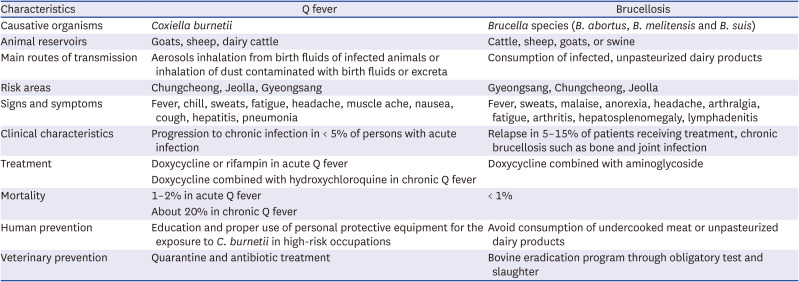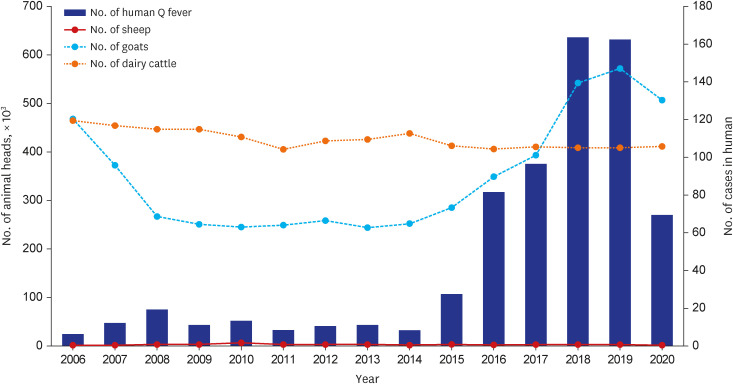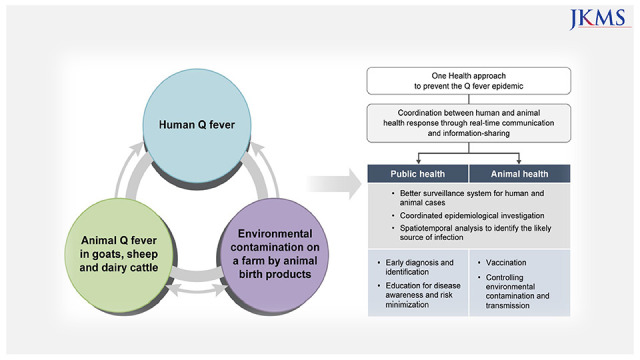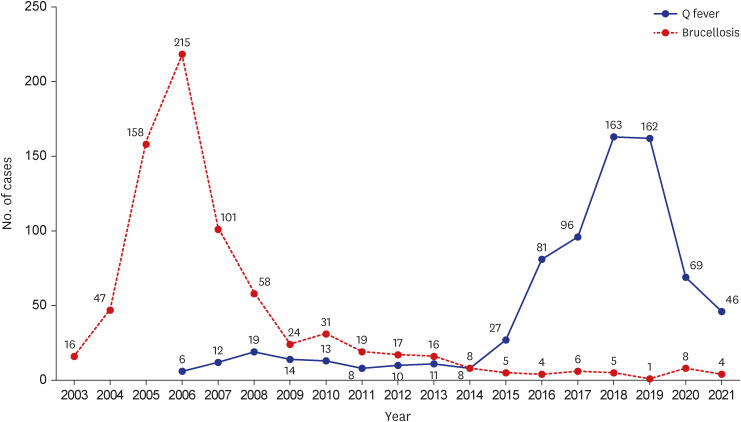1. Stein A, Raoult D. Pigeon pneumonia in provence: a bird-borne Q fever outbreak. Clin Infect Dis. 1999; 29(3):617–620. PMID:
10530457.
2. Buhariwalla F, Cann B, Marrie TJ. A dog-related outbreak of Q fever. Clin Infect Dis. 1996; 23(4):753–755. PMID:
8909839.
3. Beaman MH, Hung J. Pericarditis associated with tick-borne Q fever. Aust N Z J Med. 1989; 19(3):254–256. PMID:
2775046.
4. Langley JM, Marrie TJ, Covert A, Waag DM, Williams JC. Poker players’ pneumonia. An urban outbreak of Q fever following exposure to a parturient cat. N Engl J Med. 1988; 319(6):354–356. PMID:
3393197.
5. Marrie TJ, Schlech WF 3rd, Williams JC, Yates L. Q fever pneumonia associated with exposure to wild rabbits. Lancet. 1986; 327(8478):427–429.
6. van der Hoek W, Dijkstra F, Schimmer B, Schneeberger PM, Vellema P, Wijkmans C, et al. Q fever in the Netherlands: an update on the epidemiology and control measures. Euro Surveill. 2010; 15(12):19520. PMID:
20350500.
7. Schimmer B, Ter Schegget R, Wegdam M, Züchner L, de Bruin A, Schneeberger PM, et al. The use of a geographic information system to identify a dairy goat farm as the most likely source of an urban Q-fever outbreak. BMC Infect Dis. 2010; 10(1):69. PMID:
20230650.
8. Racult D, Stein A. Q fever during pregnancy--a risk for women, fetuses, and obstetricians. N Engl J Med. 1994; 330(5):371.
9. Kanfer E, Farrag N, Price C, MacDonald D, Coleman J, Barrett AJ. Q fever following bone marrow transplantation. Bone Marrow Transplant. 1988; 3(2):165–166. PMID:
3048481.
10. Bamberg WM, Pape WJ, Beebe JL, Nevin-Woods C, Ray W, Maguire H, et al. Outbreak of Q fever associated with a horse-boarding ranch, Colorado, 2005. Vector Borne Zoonotic Dis. 2007; 7(3):394–402. PMID:
17896873.
11. Maurin M, Raoult D. Q fever. Clin Microbiol Rev. 1999; 12(4):518–553. PMID:
10515901.
12. Fenollar F, Fournier PE, Carrieri MP, Habib G, Messana T, Raoult D. Risks factors and prevention of Q fever endocarditis. Clin Infect Dis. 2001; 33(3):312–316. PMID:
11438895.
13. Eldin C, Mélenotte C, Mediannikov O, Ghigo E, Million M, Edouard S, et al. From Q fever to
Coxiella burnetii infection: a paradigm change. Clin Microbiol Rev. 2017; 30(1):115–190. PMID:
27856520.
16. Kim YC, Jeong HW, Kim DM, Huh K, Choi SH, Lee HY, et al. Epidemiological investigation and physician awareness regarding the diagnosis and management of Q fever in South Korea, 2011 to 2017. PLoS Negl Trop Dis. 2021; 15(6):e0009467. PMID:
34077423.
18. Acharya D, Park JH, Chun JH, Kim MY, Yoo SJ, Lewin A, et al. Seroepidemiologic evidence of Q fever and associated factors among workers in veterinary service laboratory in South Korea. PLoS Negl Trop Dis. 2022; 16(2):e0010054. PMID:
35108271.
20. Kim M, Yi H, Chun JH, Hwang KJ. Survey of sero-prevalence to coxiellosis among high risk groups of Q-fever in South Korea, 2007-2019. Public Health Wkly Rep. 2020; 13(33):2467–2477.
21. Song J, Lee HS, Lee JY, Shin S, Kwon GY, Kim M, et al. Seroprevalence of Q fever in goat farm workers in the Republic of Korea, 2020. Public Health Wkly Rep. 2021; 14(44):3111–3119.
23. Na HM, Bae SY, Koh BR, Park JS, Seo YJ, Jeong H, et al. Prevalence of antibody titers for Coxiella burnetii in cattle in Gwangju area, Korea. Korean J Vet Serv. 2016; 39(2):125–129.
24. Gang SJ, Jeong JM, Kim HK, Lee JW, Shon K, Park TW. Prevalence of Coxiella burnetii in native Korean goat in Jeonbuk province. Korean J Vet Serv. 2016; 39(4):239–246.
25. Kim SG, Cho JC, Lee MG, Kim SS, Lee SH, Kwak DM. Seroprevalence of Coxiella burnetii in native Korean goats (Capra hircus coreanae) in Gyeongbuk province, Korea. Korean J Vet Serv. 2014; 37(4):241–246.
26. Ouh IO, Seo MG, Do JC, Kim IK, Cho MH, Kwak DM. Seroprevalence of Coxiella burnetii in bulk-tank milk and dairy cattle in Gyeongbuk province, Korea. Korean J Vet Serv. 2013; 36(4):243–248.
27. Anderson A, Bijlmer H, Fournier PE, Graves S, Hartzell J, Kersh GJ, et al. Diagnosis and management of Q fever--United States, 2013: recommendations from CDC and the Q Fever Working Group. MMWR Recomm Rep. 2013; 62:1–30.
28. van Loenhout JA, Paget WJ, Vercoulen JH, Wijkmans CJ, Hautvast JL, van der Velden K. Assessing the long-term health impact of Q-fever in the Netherlands: a prospective cohort study started in 2007 on the largest documented Q-fever outbreak to date. BMC Infect Dis. 2012; 12(1):280. PMID:
23110336.
29. Roest HI, Tilburg JJ, van der Hoek W, Vellema P, van Zijderveld FG, Klaassen CH, et al. The Q fever epidemic in The Netherlands: history, onset, response and reflection. Epidemiol Infect. 2011; 139(1):1–12. PMID:
20920383.
31. van der Hoek W, Hogema BM, Dijkstra F, Rietveld A, Wijkmans CJ, Schneeberger PM, et al. Relation between Q fever notifications and
Coxiella burnetii infections during the 2009 outbreak in The Netherlands. Euro Surveill. 2012; 17(3):20058. PMID:
22297100.
32. Oei W, Kretzschmar ME, Zaaijer HL, Coutinho R, van der Poel CL, Janssen MP. Estimating the transfusion transmission risk of Q fever. Transfusion. 2014; 54(7):1705–1711. PMID:
24456030.
33. Kampschreur LM, Delsing CE, Groenwold RH, Wegdam-Blans MC, Bleeker-Rovers CP, de Jager-Leclercq MG, et al. Chronic Q fever in the Netherlands 5 years after the start of the Q fever epidemic: results from the Dutch chronic Q fever database. J Clin Microbiol. 2014; 52(5):1637–1643. PMID:
24599987.
34. Million M, Thuny F, Richet H, Raoult D. Long-term outcome of Q fever endocarditis: a 26-year personal survey. Lancet Infect Dis. 2010; 10(8):527–535. PMID:
20637694.
35. Botelho-Nevers E, Fournier PE, Richet H, Fenollar F, Lepidi H, Foucault C, et al.
Coxiella burnetii infection of aortic aneurysms or vascular grafts: report of 30 new cases and evaluation of outcome. Eur J Clin Microbiol Infect Dis. 2007; 26(9):635–640. PMID:
17629755.
36. Million M, Roblot F, Carles D, D’Amato F, Protopopescu C, Carrieri MP, et al. Reevaluation of the risk of fetal death and malformation after Q Fever. Clin Infect Dis. 2014; 59(2):256–260. PMID:
24748522.
37. Munster JM, Leenders AC, Hamilton CJ, Meekelenkamp JC, Schneeberger PM, van der Hoek W, et al. Routine screening for
Coxiella burnetii infection during pregnancy: a clustered randomised controlled trial during an outbreak, the Netherlands, 2010. Euro Surveill. 2013; 18(24):20504. PMID:
23787163.
38. Quijada SG, Terán BM, Murias PS, Anitua AA, Cermeño JL, Frías AB. Q fever and spontaneous abortion. Clin Microbiol Infect. 2012; 18(6):533–538. PMID:
22471505.
39. Carcopino X, Raoult D, Bretelle F, Boubli L, Stein A. Managing Q fever during pregnancy: the benefits of long-term cotrimoxazole therapy. Clin Infect Dis. 2007; 45(5):548–555. PMID:
17682987.
40. Park MY, Lee CS, Choi YS, Park SJ, Lee JS, Lee HB. A sporadic outbreak of human brucellosis in Korea. J Korean Med Sci. 2005; 20(6):941–946. PMID:
16361801.
41. Lim JS, Min KD, Ryu S, Hwang SS, Cho SI. Spatial analysis to assess the relationship between human and bovine brucellosis in South Korea, 2005-2010. Sci Rep. 2019; 9(1):6657. PMID:
31040303.
42. Lee BY, Higgins IM, Moon OK, Clegg TA, McGrath G, Collins DM, et al. Surveillance and control of bovine brucellosis in the Republic of Korea during 2000-2006. Prev Vet Med. 2009; 90(1-2):66–79. PMID:
19361875.
43. Yoon H, Moon OK, Her M, Carpenter TE, Kim YJ, Jung S, et al. Impact of bovine brucellosis eradication programs in the Republic of Korea. Prev Vet Med. 2010; 95(3-4):288–291. PMID:
20493568.
44. Ryu S, Soares Magalhães RJ, Chun BC. The impact of expanded brucellosis surveillance in beef cattle on human brucellosis in Korea: an interrupted time-series analysis. BMC Infect Dis. 2019; 19(1):201. PMID:
30819243.
46. Byeon HS, Han MN, Han ST, Chae MH, Kang SS, Jang RH, et al. Massive human Q fever outbreak from a goat farm in Korea. J Biomed Transl Res. 2020; 21(4):200–206.
47. Kersh GJ, Wolfe TM, Fitzpatrick KA, Candee AJ, Oliver LD, Patterson NE, et al. Presence of
Coxiella burnetii DNA in the environment of the United States, 2006 to 2008. Appl Environ Microbiol. 2010; 76(13):4469–4475. PMID:
20472727.
48. Angelakis E, Raoult D. Q fever. Vet Microbiol. 2010; 140(3-4):297–309. PMID:
19875249.
49. Enright JB, Sadler WW, Thomas RC. Pasteurization of milk containing the organism of Q fever. Am J Public Health Nations Health. 1957; 47(6):695–700. PMID:
13424814.
50. Stephen S, Rao KN. Coxiellosis in reptiles of South Kanara district, Karnataka. Indian J Med Res. 1979; 70:937–941. PMID:
541017.
52. McDermott J, Grace D, Zinsstag J. Economics of brucellosis impact and control in low-income countries. Rev Sci Tech. 2013; 32(1):249–261. PMID:
23837382.
54. de Cremoux R, Rousset E, Touratier A, Audusseau G, Nicollet P, Ribaud D, et al.
Coxiella burnetii vaginal shedding and antibody responses in dairy goat herds in a context of clinical Q fever outbreaks. FEMS Immunol Med Microbiol. 2012; 64(1):120–122. PMID:
22066517.
55. Guatteo R, Beaudeau F, Joly A, Seegers H.
Coxiella burnetii shedding by dairy cows. Vet Res. 2007; 38(6):849–860. PMID:
17903418.
56. Rousset E, Berri M, Durand B, Dufour P, Prigent M, Delcroix T, et al.
Coxiella burnetii shedding routes and antibody response after outbreaks of Q fever-induced abortion in dairy goat herds. Appl Environ Microbiol. 2009; 75(2):428–433. PMID:
19011054.
57. Schimmer B, Dijkstra F, Vellema P, Schneeberger PM, Hackert V, ter Schegget R, et al. Sustained intensive transmission of Q fever in the south of the Netherlands, 2009. Euro Surveill. 2009; 14(19):19210. PMID:
19442401.
58. Van den Brom R, Vellema P. Q fever outbreaks in small ruminants and people in the Netherlands. Small Rumin Res. 2009; 86(1-3):74–79.
59. Anderson A, Boyer T, Garvey A, Marshall K, Menzies P, Murphy J, et al. Prevention and control of
Coxiella burnetii infection among humans and animals: guidance for a coordinated public health and animal health response, 2013. Updated 2013. Accessed February 9, 2023.
http://www.nasphv.org/Documents/Q_Fever_2013.pdf
.
60. Bond KA, Vincent G, Wilks CR, Franklin L, Sutton B, Stenos J, et al. One Health approach to controlling a Q fever outbreak on an Australian goat farm. Epidemiol Infect. 2016; 144(6):1129–1141. PMID:
26493615.
61. Van den Brom R, van Engelen E, Roest HI, van der Hoek W, Vellema P.
Coxiella burnetii infections in sheep or goats: an opinionated review. Vet Microbiol. 2015; 181(1-2):119–129. PMID:
26315774.
62. Heo JY, Choi YW, Kim EJ, Lee SH, Lim SK, Hwang SD, et al. Clinical characteristics of acute Q fever patients in South Korea and time from symptom onset to serologic diagnosis. BMC Infect Dis. 2019; 19(1):903. PMID:
31660875.
63. Fournier PE, Marrie TJ, Raoult D. Diagnosis of Q fever. J Clin Microbiol. 1998; 36(7):1823–1834. PMID:
9650920.
64. Fournier PE, Raoult D. Comparison of PCR and serology assays for early diagnosis of acute Q fever. J Clin Microbiol. 2003; 41(11):5094–5098. PMID:
14605144.
65. Schneeberger PM, Hermans MH, van Hannen EJ, Schellekens JJ, Leenders AC, Wever PC. Real-time PCR with serum samples is indispensable for early diagnosis of acute Q fever. Clin Vaccine Immunol. 2010; 17(2):286–290. PMID:
20032219.
67. Arricau-Bouvery N, Souriau A, Bodier C, Dufour P, Rousset E, Rodolakis A. Effect of vaccination with phase I and phase II
Coxiella burnetii vaccines in pregnant goats. Vaccine. 2005; 23(35):4392–4402. PMID:
16005747.
68. Hogerwerf L, van den Brom R, Roest HI, Bouma A, Vellema P, Pieterse M, et al. Reduction of
Coxiella burnetii prevalence by vaccination of goats and sheep, The Netherlands. Emerg Infect Dis. 2011; 17(3):379–386. PMID:
21392427.
69. Lepidi H, Houpikian P, Liang Z, Raoult D. Cardiac valves in patients with Q fever endocarditis: microbiological, molecular, and histologic studies. J Infect Dis. 2003; 187(7):1097–1106. PMID:
12660924.
70. Fournier PE, Thuny F, Richet H, Lepidi H, Casalta JP, Arzouni JP, et al. Comprehensive diagnostic strategy for blood culture-negative endocarditis: a prospective study of 819 new cases. Clin Infect Dis. 2010; 51(2):131–140. PMID:
20540619.
71. Kampschreur LM, Oosterheert JJ, Koop AM, Wegdam-Blans MC, Delsing CE, Bleeker-Rovers CP, et al. Microbiological challenges in the diagnosis of chronic Q fever. Clin Vaccine Immunol. 2012; 19(5):787–790. PMID:
22441385.
72. Kampschreur LM, Wegdam-Blans MC, Wever PC, Renders NH, Delsing CE, Sprong T, et al. Chronic Q fever diagnosis—consensus guideline versus expert opinion. Emerg Infect Dis. 2015; 21(7):1183–1188. PMID:
26277798.
73. Wielders CC, van Loenhout JA, Morroy G, Rietveld A, Notermans DW, Wever PC, et al. Long-term serological follow-up of acute Q-fever patients after a large epidemic. PLoS One. 2015; 10(7):e0131848. PMID:
26161658.






 PDF
PDF Citation
Citation Print
Print





 XML Download
XML Download